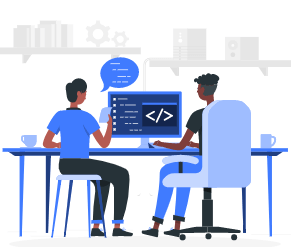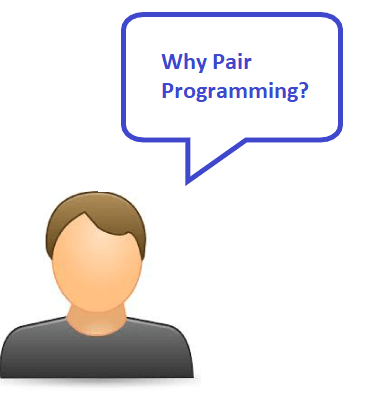Pair Programming
OverviewDevelopers are expected to deliver their best they are empowered and motivated constantly. This inspiration and motivation can also point to the availability of adequate resources or tools. A senior developer is ready to help at any instance, or an ambient workplace that blends the developer with agility and accuracy to develop products faster and bug-free. Companies try to keep their developers in such an environment because they know that providing proper tools and environment would help employees do more and benefit them by faster product development. Moreover, there are also several tactics to achieve these goals, which can be followed in tandem. The resources for developers need to be efficient enough to fit their requirements apart from the tools they are using. Other techniques like performance monitoring can opt for a proactive approach to monitoring rather than responding to the occurring issue only after the end-user has received it. Similarly, one more popular method that can deliver the best efficiency is pair programming. Let's look at this technique, the core concepts, challenges, and advantages in detail. What is Pair ProgrammingAs the name implies, pair programming can be considered as two individuals and one machine. Precisely, it is the practice of having two developers and one working machine so that both the individuals can combine and collaborate to work on one aspect. In this practice, both the individuals have one keyboard and a mouse. One programmer is supposed to code, and the other programmer is told to observe the code. He checks whether the code being written is apt for the required project. He also spells, checks it, and figures out whether the written code goes wrong somewhere and the next step. The coder's individual's task is to code according to the requirement, and he need not worry about what is being written since the other programmer is proofreading it. The roles can be switched anytime; the driver becomes the observer and vice versa. Both form pairs and work effectively so that time is saved and the code is easy to debug. This is the reason why it is also called "pairing" or "programming in pairs". 
Why Pair Programming?Listed below are some key factors that we consider best possible answers to why pair programming is used:
Advantages of Pair ProgrammingThere are various compelling reasons we can take into consideration as advantages of pair programming. Therefore, we have discussed some of the core advantages of pair programming broadly below. 1. Better than oneTwo brains are always better than one. Consider an instance where the driver encounters a glitch in the code. He's not alone who is inside these loopholes. There are two smart minds to handle the issue. We might think that two minds can have two differences to solve the issue, but which solution can be taken into account to solve the issue might take time. We can also assume that this may down the project completion because two programmers are putting their heads to develop a single program instead of working on two different programs individually. But according to the studies and research carried out by different organizations, results suggest that combining both the programmers into one program is only 15% slower than the required time. In contrast, if they are assigned to work on two different programs individually, the slow-down rate goes close to about 50%. This means that when two people work on one problem collectively, the problem is solved faster than that of one person working on one program. This one reason is enough to state why two are better than one. 2. Lesser coding mistakesWhen two minds are focused on one task, there is less chance of mistakes because another programmer is looking at whatever the other programmer is doing. Thus, it results in better code. A study proposed by an online survey stated that 15% fewer bugs are written by pair programmers than solo programmers. Plus, pair programming lets the driver stay focused on the code without worrying about external interruptions or matters. 3. Better knowledge exchangePair programming is a great way to share knowledge. Both the fellow programmers can talk and seek help anytime. It allows the programmers to have a face-to-face interaction because it can deliver much better results than boring online tutorials. The programmer can learn better than the resources available on the internet. Another case where pair programming sets a milestone is that both the fellow programmers can learn different things, especially for those areas where the other may not have any knowledge. Developers are therefore advised to keep up the best practices and build a better relationship as a programmer. 4. Interpersonal skill enhancementPair programming always results in the development of great interpersonal skills. Collaborating on a single project promotes both the programmers to appreciate each other's core values, communications and promotes teamwork. It sums up the developers to individually communicate and drive a solution-based approach to proceed with a problem without worrying about bugs and glitches. This results in better code quality. 5. Better retention rateAt times, a solo developer gets frustrated with using the same design pattern to solve complex and hypothetical codes that are too generic for him. Often, he declines the power of collaborating because he may need some space to think better. On a personal plan, this may seem right, but in general, it is not fruitful for the long run. Introducing pair programming to the solo developer may help him get the correct approach to solve complex problems using the design pattern suggested by the other programmer because they might be aware of solving the problem with ease. This inflates the retention rate of the organization. Apart from the retention rate, fewer mistakes are introduced in pair programming if the programmer is not in the state of being fired. Both the fellow programmers can thus have continuous attrition and code reviews. It can also be said that the developer knows more people who can help them know how the program runs because if one of the programmers leaves the company, it will not kill the project. Code Review vs. Pair ProgrammingCode reviews can be called the process to view any code and pass judgment. The programmer looks at the code to find defects and suggests improvements. Code review also combines some testing methods so that quality is ensured. However, it is challenging to find someone who can review our code because others don't want to see others' codes since they have difficulty reading and understanding the style and quality. Most of the time, code review consists of adding some functionalities, code cleanliness, and bug fixing, but it also carries a drawback of less appreciation from code reviewers. On the other hand, pair programming, if compared to code review, is like having a constant companion who constantly reviews your code while you write. The programmers form a pair, i.e., one coder and another reviewer, and this position can be swapped. This promotes the effective use of time and less burnout for an individual. Challenges to Pair ProgrammingThe common problems associated with pair programming include the following: 1. Equal ParticipationIn pair programming, both individuals are required to have equal engagement and perspective for the assigned task. Else, there are no benefits. Sometimes, one of the programmers might feel overwhelmed with just dry reading, or the other might be under the constant pressure of writing code. Therefore, equal participation and effort is an important aspect of pair programming. 2. Delay anomalyPeople who haven't tried pair programming have a vision that pair programming might double the cost and time of the project because it takes two programmers. However, it is a big misconception that needs to be clarified. Based on researches carried out through surveys and practices, it has been found that pair programming, if done right results speed up the coding to about 15%. It also enhances the code quality by having fewer bugs, thereby stopping the chances of redoing the same task or repeatedly repeating the code review process. 3. Background and GuidelinesPair programming is a structured technique. It has a clear intention about how to implement it using certain guidelines. If followed properly, pair programming is very efficient. Pair programming is considered effective if the programmers have a basic understanding of the following guidelines:
ProceduresPair programming needs some ambient procedures and planning. Without following some crucial procedures, it cannot be taken forward effectively. Hence, to initiate it, the following procedures are needed to be strictly followed: Physical SpaceSetting up a physical space is an important setup for pair programming. It simply points to the workspace for both the programmers where they can sit next to each other, orienting the same computer. They must have all the required resources in hand for smooth flow. Planning PeriodThe planning period is the process of executing certain tasks at the decided time interval. Before moving towards their destination, programmers are required to develop a mental roadmap and discuss all the aspects of it so that opinions don't differ at any point in time. The discussion may include the design principles, the intention behind the project, what stacks will be used, and how much duration is needed for the project. At the end of the planning, the programmers are expected to share the same objective and workflow that makes sense to them and decide where they are going. Role AssignmentBefore proceeding with pair programming, both the programmers must have some prior discussion on who will address the driver or the navigator role. Both individuals can only decide this. If one programmer feels that he is good at writing code or being a navigator/observer, then the process can be carefully initiated and acted upon. Based on the discussion, the following roles are needed to be shared amongst the driver and navigator: The Driver
The Navigator
Final thoughts Pair programming is a great practice if done correctly. It is one of the most underrated techniques where an individual can learn fast and apply the learned concepts without worrying about the drawbacks. Pair programming introduced itself quite a long time ago but was not considered until it became too late. Thus, big companies often push their developers for pair programming rather than sit and code alone. As we saw in this article, pair programming, though it suffers from some disadvantages, should be implemented quite often because research has been carried out on pair programming. The proverb "two is better than one" beholds the power of pair programming.
Next TopicWow.js
|
 For Videos Join Our Youtube Channel: Join Now
For Videos Join Our Youtube Channel: Join Now
Feedback
- Send your Feedback to [email protected]
Help Others, Please Share









